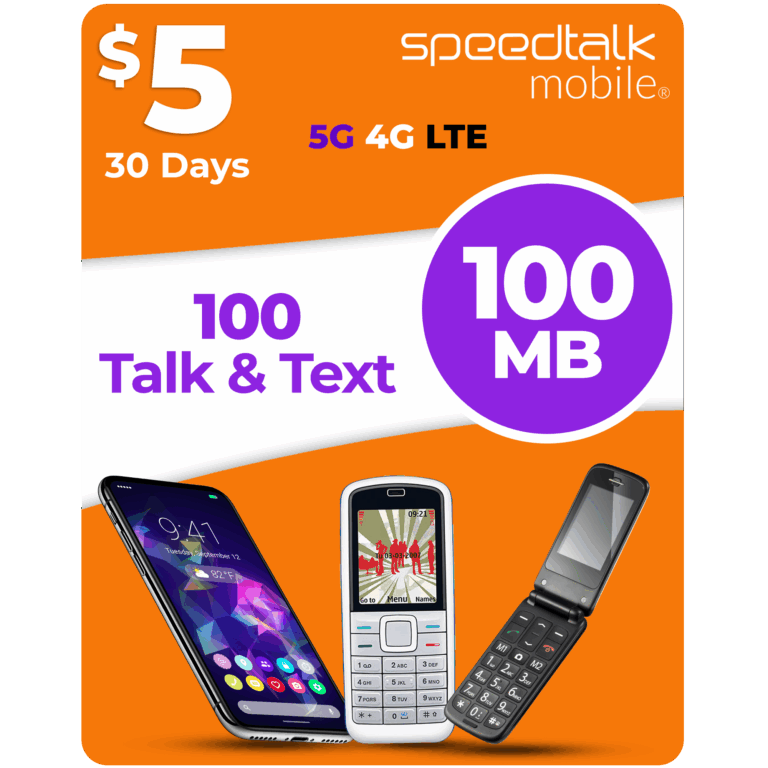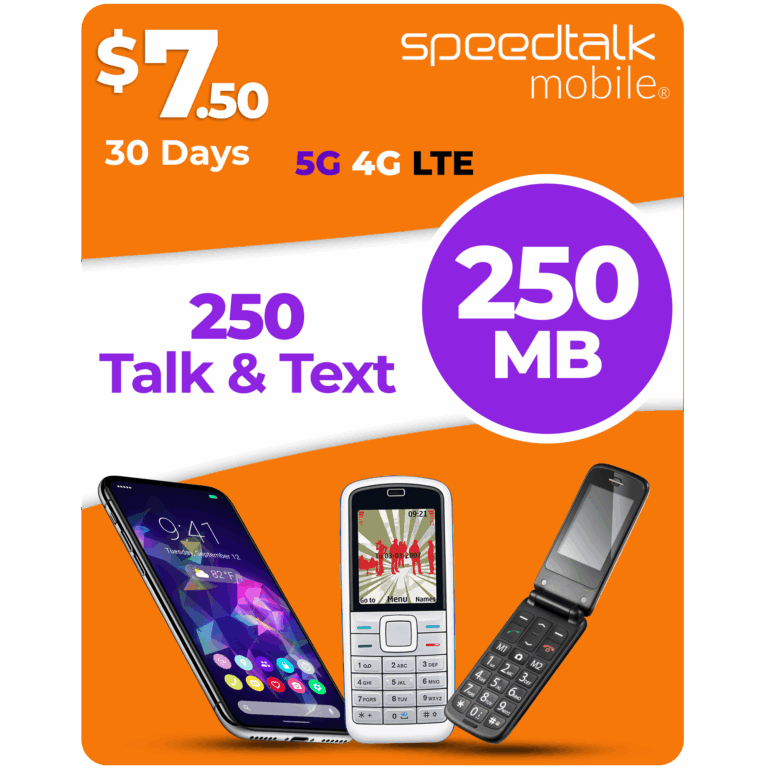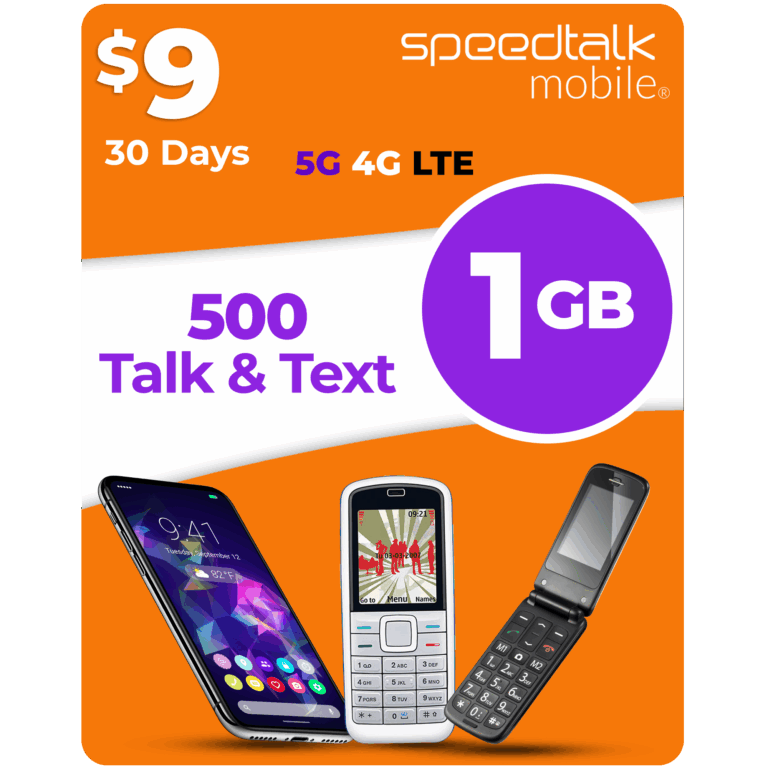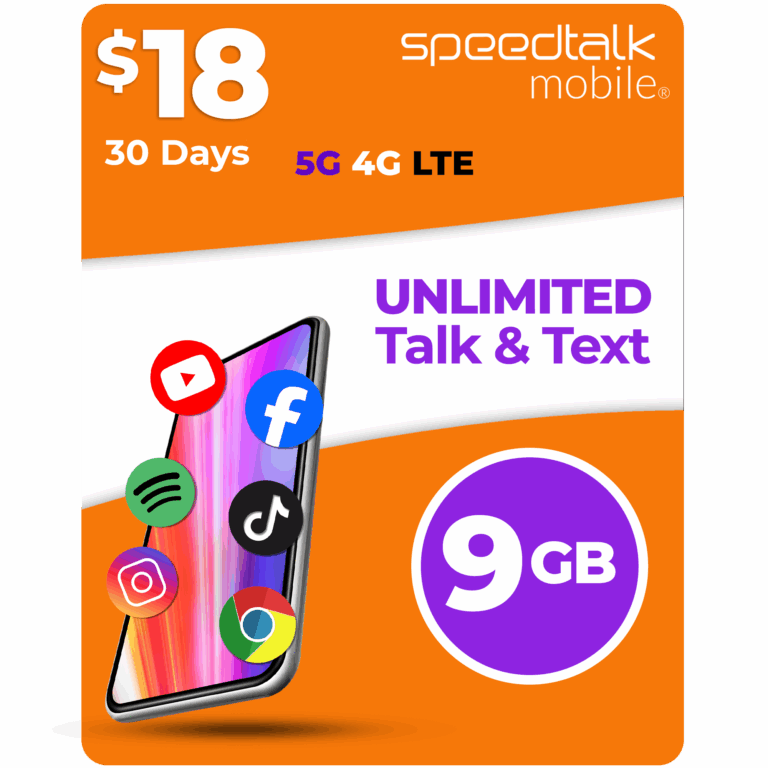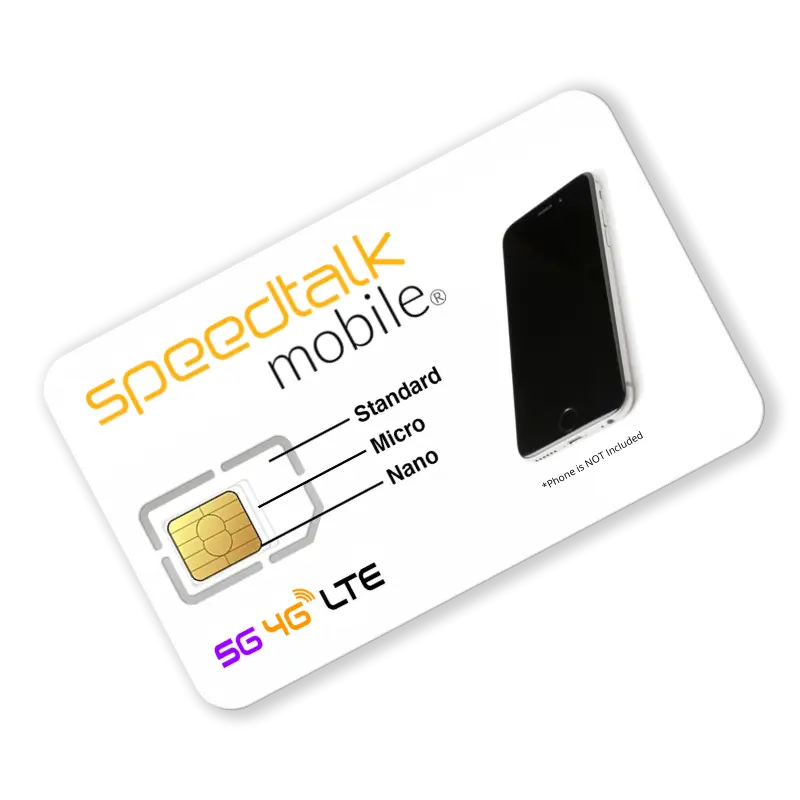Top Value Mobile Phone Plans

- No Contracts!
- No Credit Checks!
- No Commitments!
Get top value UNLIMITED Mobile Phone Plans service at a fraction of the cost with no contract smartphone & cell phone plans on the nation’s fastest 5G/4G/LTE network for hundreds per year in savings on your wireless plan
Top Value Phone Plans
Our Top Value Plans lets you try out our Mobile Services at the lowest price possible!
Buy 6 months get 7th month free

See Data Only Plan
Our IOT and Broadband service will connect you to our SpeedTalk Network and will work in over 200 countries including the United States, Canada, Mexico and internationally.
Top Value "Unlimited"
Mobile Phone Plans
Save more with a top value unlimited plan on the nations largest, and most dependable 5G & 4G LTE networks. Best part there is no contracts. If you’re tired of data limits and overage charges, you may want to take a look at unlimited plans. Plus, receive even greater value when you sign up to one of these monthly unlimited top value plans.
From the top value unlimited data, talk and text to the best mobile phone deals, we have the best options for you and your wireless needs. You get UNLIMITED wireless service on the nation’s largest 5G 4g LTE networks, but for way less than what big wireless companies charge for top value unlimited phone plans.
SpeedTalk Mobile Phone service will switch seamlessly between 5G & 4G LTE networks, whichever is strongest at your location.
If you’re looking to switch to a new unlimited phone provider, and are willing to switch your mobile phone number from a competitor, Your unlocked device and current phone number are always welcomed here! Here’s a list of Top value unlimited phone plans that are available with SpeedTalk Mobile.
UNLIMITED Wireless,
For A Whole Lot Less!
The Top Value Unlimited Plans offer unlimited talk, text and data for a fixed monthly fee. These plans are perfect for individuals who need high-speed data access without worry of exceeding their monthly cap. SpeedTalk is the most competitive subscription wireless service. Renewable prepaid plans for cell phones, smartwatches, GPS trackers, and more. No contract, No credit checks, and 100% money-back guaranteed.
Coverage you can count on!
Dependable Wireless, And Affordable Service!
4G / 5G NATIONWIDE NETWORK
You get premium wireless service on the nation’s largest 4G / 5G network, for less than what big wireless companies charge.
FLEXIBLE WIRELESS PLANS
Choose the monthly usage amount. That is right! If you are not using it, you can switch to a lower plan at anytime.
BYOE (BRING YOUR OWN EVERYTHING)
Your unlocked device and current phone number are always welcome at SpeedTalk Mobile®
NO CONTRACTS!
NO COMMITMENTS!
There is never any contracts or commitments. Start and continue service when you want.
Unlimited phone plans are Compatible With All GSM SIM CARD Wireless Devices
MUST USE GSM ESIM OR SIM CARD TECHNOLOGY
TOP VALUE UNLIMITED PLANS
Our Top Value Plans Lets You Try Out Our Mobile Services At The Lowest Price Possible! The best SpeedTalk Mobile Unlimited Plans listed out just for you.
PAY AS YOU GO PHONE PLANS
Flexible wireless plans for everyone. We realize that not all plans are created equal and we each use our wireless devices for different reasons. That is why we offer a wide range of plans to fit anyone's needs.
TRUE PREPAID PHONE PLANS
TRUE PREPAID offers the lowest, most affordable, rates. Whether you choose between Text/Data/Minutes or a combination of all three, it’s just $0.02 per Minute/Text/MMS or MB of Data. If you go beyond your chosen plan level, no worries.
Frequently Asked Speedtalk Mobile Questions
Is my phone compatible with SpeedTalk?
The following phones work with our service
iPhone – All models –
All 4G LTE GSM phones –
All phones purchased through T-Mobile –
All phones purchased through AT&T but they have to be unlocked – Only 2016 and newer phones purchased through Verizon & Sprint.
Android – All models –
All 4G LTE GSM phones –
All phones purchased through T-Mobile –
All phones purchased through AT&T but they have to be unlocked – Only 2016 and newer phones purchased through Verizon & Sprint
Windows – Most windows phones.
Non-smartphones – All models –
All 4G LTE GSM – Unlocked
Other – All models –
All 4G LTE GSM – Unlocked
Can I transfer my existing cell phone number?
The transfer process will take part once you have received a SIM card in the mail from SpeedTalk and ready to activate your service with us. We will ask you for your account # and password from your current carrier. Phone number must be active with the current carrier to ensure the transfer of your number to SpeedTalk network.
Keep in mind that there are exceptions to this rule, but it will never be because of SpeedTalk. Your phone will have to be in good standing with your current or past carrier. You will also have to purchase one of our plans first and you should start the transfer process with SpeedTalk prior to your cancellation with your current carrier. It’s very important that you do not cancel your account with your current carrier before the transferring process is completed.
If you currently do not have a phone number. SpeedTalk will generate one for you automatically, you just need to provide a zip code so we can issue a phone number based on that zip code. (It’s important to enter the zip code of the area where you will regularly use your device)
Can I cancel anytime?
Yes, you can. We are a combination of subscription and pre-paid plans.
Is this service a money back guaranteed?
We are a 100% money back guaranteed service. However, if you have consumed more than 30 minutes, 30 texts, or 30 MBs of data within 14 days of the plan cycle, your purchase will be considered buyer’s remorse and you will no longer qualify for a refund.
What is a SIM Card?
A SIM card is an integrated circuit intended to securely store the international mobile subscriber identity number and its related key, which are used to identify and authenticate subscribers on mobile telephony devices.
a SIM (Subscriber Identity Module) card is a tiny, portable memory chip that stores information about you as a cell phone user. On it, there’s a seventeen-digit code that designates its country code of origin, the system carrier (such as AT&T or Verizon), and a unique user ID.
You may wonder, “Who cares about this code?” A valid question and guess what: phone carriers do. It’s how they attribute cell phone bills and charge us.
Above all else, SIM cards are super handy because they can be easily transferred from one device to another. Just like in my opening story, all that you’d need to do is take it out of one phone and slip it into the new one. By making the switch, most (if not all) of your contacts and personal settings will transfer with it, making life all the easier.
SIM cards were introduced all the way back in 1991. The first SIM card was about the size of a credit card. Since then, there have been several updates and iterations, making them smaller and smaller.
This evolution closely aligns with the history of the GSM (Global System of Mobile Communications) mobile network. Developed to describe protocols for second generation (2G) (3G) (4G) AND (5G) cellular networks, the GSM today stands as the default global standard for mobile communications.
SIM cards are a crucial part of GSM networks, storing user information required for authentication. Ultimately, this allows both your phone to connect with a GSM network and GSM networks to track your phone usage (specifically, your minutes, texts, data usage, etc), giving carriers the information to send you an accurate phone bill.
GSM is the standard network in America, Europe, Asia, Africa, and most other places. Interestingly, besides GSM, the United States has an additional network called CDMA (Code Division Multiple Access) that is used by carriers such as Verizon and Sprint. Phones on the GSM or CDMA network can use any carrier’s network, lowering the costs for the carriers and its users.
When it comes to your phone’s connection with either network, SIM cards are essentially the brain of your device.
A SIM Card is a chip that all devices carry. The chip that communicates with our network.
Are there different types of sim cards?
There are four basic sizes of SIM card: the standard, the micro, nano, and esims.
Of the four, the Standard is the original SIM and the largest. Today, these are mainly used on older phones.
The Micro SIM card is essentially a standard SIM card with the extra plastic around the circuit board trimmed off.
A trimmed version of the Micro, the Nano is the smallest and used on today’s iPhones. Although minuscule compared to prior versions, the Nano still holds the same amount of data as earlier SIM cards.
Mini-SIM
When skimming the evolution of the SIM card, you likely noticed that they’ve become much smaller. But prior to the launch of the iPhone 4 in 2010, we really only had one SIM card size. Introduced in ‘96, it was the standard used in every phone and it made the GSM folks happy. Essentially, it was your entire phone on a card. It made things simple. If you wanted a new phone, all you’d need to do was take that SIM out, pop it into any phone and suddenly your phone number would be transferred to the new device. For over a decade, this was the standard, which made switching phones a breeze. Now? Not so much.
Micro-SIM
Enter Apple. Wanting to save precious room for its newest generation of smartphones, Apple switched from using the standard Mini-SIM to the Micro-SIM once the iPhone 4 hit shelves.
Surprisingly, the Micro-SIM wasn’t some new flashy SIM developed for the latest iPhone. Believe it or not, it was first introduced in 2003.
Back then, its purpose was clear: if a device was too small to fit a mini-SIM, you’d have to use the micro-SIM. In addition, the micro-SIM was designed for backward compatibility, meaning it can work with input generated by an older version of the SIM (such as the Mini-SIM).
In addition, despite its smaller size, the micro’s performance wasn’t impacted at all, as chip’s contact area remained the same. It turned out to be scaled down – the card only needed its excess plastic to be cut from it.
When Apple released the iPhone 4 with the micro-SIM, it became the standard for most smartphones. Samsung, Nokia, and HTC are just a few of the manufacturers that adopted the new Micro-SIM. During this time, several upgrading to the iPhone 4 opted to use an adapter to get their SIM cards cut down to Micro’s, as well.
Nano-SIM
If you thought Apple was done using smaller SIM cards, think again. Perhaps Apple was peeved they had to use a SIM card from 2003 on the shiny new iPhone 4. Maybe they just wanted to stay ahead of the curve and throw competitors off their trail.
In any case, the launch of the iPhone 5 prompted the public to realize there was a new SIM in town: the Nano-SIM. This choice to go small made life pretty difficult for users. Anyone upgrading to an iPhone 5 or switching from Android now had to get a new SIM card or an adapter.
Fortunately, most smartphones released since 2014 (both iOS and Android) now support Nano SIM card technology as the standard. Still, it’s sad to see a card that small take over, as it was always much easier changing phones with the Standard SIM compared to the Nano.
eSIM and Soft SIM
Now, where will the SIM card go in the future? Judging from the trend, it’ll likely be the size of a speck of dust, so insignificant that you wouldn’t even feel it in your hand.
No. I’m joking, that would be horrible. But get this: the next version of the SIM likely will be impossible to hold. That’s because it will be entirely virtual.
Cards like the eSIM and the Soft SIM are looking to be the next carnation of the SIM card we’ll see, a software “card” that carries all of the SIM’s original functions without any of the plastic or brass hardware bits.
One cool aspect of this new class of SIMs is that subscribers are able to switch operators easily, without swapping the physical SIM card. Given that this transfer is possible, maybe software-based cards are the answer when it comes to the hassles that came with switching phones over the years.
But despite its conveniences, the eSIM and soft SIM have their fair share of detractors. One potential risk that has been raised by networks regarding these SIMs is the issue of security. With hackings only becoming more prevalent, perhaps it’s hasty to lock all of a subscriber’s credentials and data into the OS of their device without building better cyber defenses against them.
It’s plausible that as the eSIM and Soft SIM are further developed, risks will be addressed until this version of the SIM overshadows the physical SIM, rendering it obsolete. In a way, it’s surprising that the SIM is only at this point of going digital now. As a product of the 1990’s, it’s amazing to consider the SIM card’s evolution, especially when compared to how fast other technologies of the era morphed and died out as newer solutions were innovated. As a link tying together the subscriber’s phone data with their network, the SIM card’s purpose has always been clear – but it will be interesting to watch what another two decades do for the future of this purpose and the SIM card itself.
How to Replace SIM Cards?
Inserting or removing a SIM card is an easy process once you determine where it is stored on your phone. Depending on the type of phone, it could be placed behind the battery. In that case, you will have to open the back panel. For other phones, the SIM cards can be found on the side of the phone.
Removing the SIM card is simple if you have the right tool. Depending on what kind of phone you have, you can easily pop it out of the slot with a paperclip or the edge of something like a credit card. There are some SIM cards that are in easier spots that can slide out with the tip of your finger.
Is installing the SIM card hard?
Not at all, it takes about ten seconds. Take a look at this example of someone placing a SIM card in a phone.
HOW-TO REPLACE A SIM CARD VIDEO
If you are not sure how to insert the SIM card, look up your phone manufacturer’s instructions online or watch a video on how to easily replace the card in the right slot.

